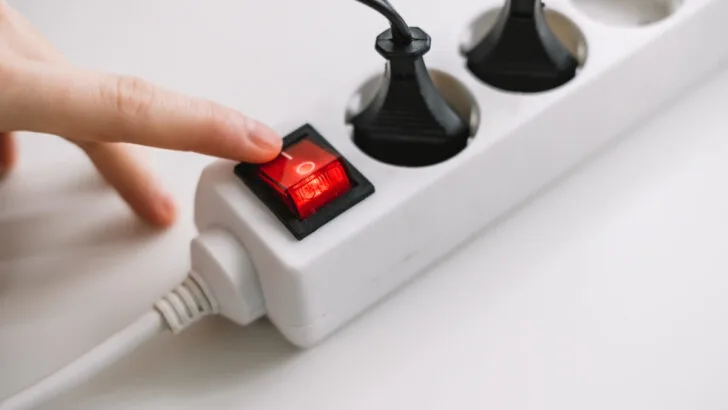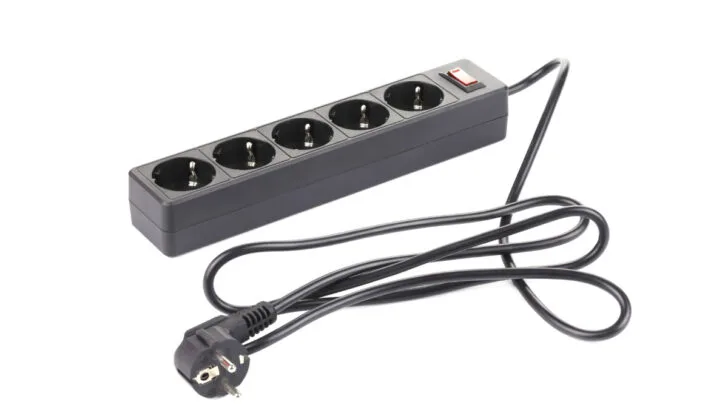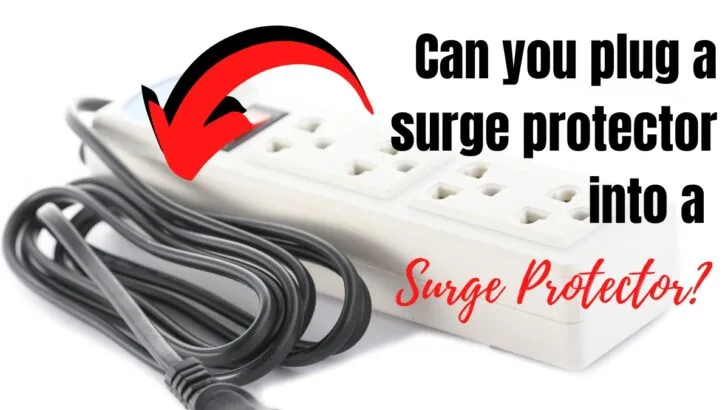Surge protectors let you plug many things into one wall outlet to protect your electronics from power surges. But can you plug a surge protector into a surge protector?
Plugging a surge protector into another surge protector is a bad idea and may even start a fire. Plugging several things into essentially one socket may blow a fuse or worse.
If you plug in too many things, too much power will come out of the wall. Only plug a surge protector into a wall outlet and not another surge protector.
Can You Plug a Surge Protector Into Another Surge Protector?
You technically can do this, but it’s not a good idea. Don’t think that two surge protectors double the protection. If you want better protection than a regular surge protector gives you, there are other products you can use.
You are creating a hazard when you plug one surge protector into another.
You can only maximize protection by buying a more expensive surge protection product.
Usually, a single regular surge protector is enough to protect your electronic devices from a power surge. If you worry that it won’t be, talk to an electrician.
An electrician can install surge suppressor receptacles that make all power that comes out of your wall outlets surge-protected.
Why Is Doubling Up Surge Protectors a Bad Idea?
Creating a long chain of devices plugged into a single wall outlet can cause a fire. The more devices there are, the more electricity has to come out of your wall to power them. The level of power can become dangerously high.

This can cause a fire if it doesn’t blow a circuit breaker first. A little less than 20% of all fires that come from surge protectors occur because people create these chains.
Don’t connect a surge protector to another surge protector and then plug devices into both surge protectors. This overburdens the wall unit hazardously.
If a power surge actually does happen, you won’t be protected by two or more surge protectors. Instead, multiple surge protectors will overload the technology and make your devices more vulnerable to power surges.
There are alternatives to common surge protectors that are better. If you use regular surge protectors, only use one per power outlet.
How Do Regular Surge Protectors Work?
Surge protector power strips have two purposes, 1) to protect your electronics from a power surge and 2) to allow you to connect multiple devices to one wall outlet.
What is a Power Surge?
Sometimes, the level of electricity coming out of a wall outlet increases far more than normal. This is a power surge and it can permanently wreck your electronics. Power surges are very brief (generally only a few billionths of a second), but that is enough to damage something.

Normally, the power coming out of your wall is 120 volts. If it briefly goes above that, a surge protector can redirect power into the grounding wire.
How Do Power Surges Damage Devices?
Electricity is sort of like water in a hose: if the pressure at one end of a hose is high, the water rushes to the other end. Voltage is sort of like “pressure” for electricity. Too much pressure might cause a hose to burst; with electricity it will cause wire to heat up and burn.
Power surges sometimes do damage gradually. A small power surge won’t damage your device, but it will increase wear and tear.
How Surge Protectors Work
When electricity passes through a surge protector, it passes the electricity to whatever devices are plugged into it. If the electric current is too strong, the surge protector passes the electricity into the grounding wire and sends it back in the other direction.
Metal Oxide Varistors (MOVs)
Surge protectors use MOVs to drain the excess power into the grounding line. They include semiconductors that have a very high resistance when the current is low but a lower resistance when the current is high.
This way, the electricity normally doesn’t flow through the MOV, but does flow through the MOV when a power surge occurs and lowers the resistance.
The MOV carries power from the main electric line into the grounding line. A MOV is sort of like a pressure release valve that opens when the pressure becomes dangerously high.
Other Technologies for Surge Protection
Other technologies that have the same purpose exist. For example, a gas discharge arrester contains a gas that doesn’t conduct electricity at low voltage but does conduct it at high voltage.
If there is a power surge, the gas becomes a conductor that drains the electricity into the grounding line.
What Causes Power Surges?
People are right to associate power surges with lightning. Many people turn off and unplug their electronic devices during lightning storms because a lightning bolt hitting a power line creates a surge. Even with a surge protector, lightning can still damage your electronics.
Lightning is not the most common cause of power surges. Most power surges are smaller than and easier to protect against than those caused by lightning.
If an elevator or something else that uses a lot of power turns on, that can cause a surge. It creates a sudden increase in the power requirements, which can affect other devices and damage them.
Faulty Electrical Work
Sometimes, a house could have been wired up the wrong way. This will lead to frequent electrical problems, including power surges. The power company might also have bad equipment that they won’t fix.
Downed power lines can also lead to power surges. Since power surges may occur anywhere, you need to use protection.
Modern Devices Are More Vulnerable
Fifty years ago, people did without surge protectors. However, this is a bad idea today, as modern technology is vulnerable to power surges.
A computer or an entertainment system contains a lot of components that a power surge can easily break.
Devices that use a lot of power, such as heaters or fridges, should be plugged into a wall outlet and not into a power bar. They will draw too much power through the power bar and damage it gradually.
What Are the Alternatives?
Cheap and basic surge protectors provide a basic level of protection. More expensive surge protection systems work a lot better. Some of the options are:
- Basic power strips with 5 or 6 outlets and a low level of surge protection
- Somewhat better power strips which look the same but offer more protection
- Surge stations, which cost $30 to $100 and include superior protection plus circuit breakers
- Uninterruptible power supplies, which not only protect you from surges, but provide backup power during a blackout
Key Takeaways to Surge Protectors
Plugging a surge protector into another surge protector is unsafe, and should not be done.
Only use one surge protector on each wall outlet. Don’t plug too many things in, or you could blow a fuse or even start a fire.
Don’t expect more than one surge protector to give you extra protection. The technology doesn’t work that way.


